Health Promotion Intervention for Young Women with Anorexia (Essay)
VerifiedAdded on 2022/12/01
|12
|4366
|393
Essay
AI Summary
This essay focuses on designing a health promotion intervention for young women aged 14-18 who are suffering from or are at risk of developing anorexia nervosa. The introduction provides a brief overview of anorexia, an eating disorder characterized by a significant decrease in appetite and an obsession with weight loss. The essay outlines the background of the health topic, emphasizing the psychological and societal factors contributing to anorexia. The chosen planning model is the PRECEDE-PROCEED model, which is used to structure the intervention strategy and includes phases like social, epidemiological, and ecological assessments. The intervention strategy involves cognitive behavioral therapy (CBT) and cognitive analytical therapy (CAT), aimed at addressing distorted views about weight, shape, and appearance, and developing healthy coping mechanisms. The essay includes a critique of the planning model and concludes with a discussion of the intervention's potential impact on reducing the prevalence of anorexia among young women.

ESSAY
Paraphrase This Document
Need a fresh take? Get an instant paraphrase of this document with our AI Paraphraser
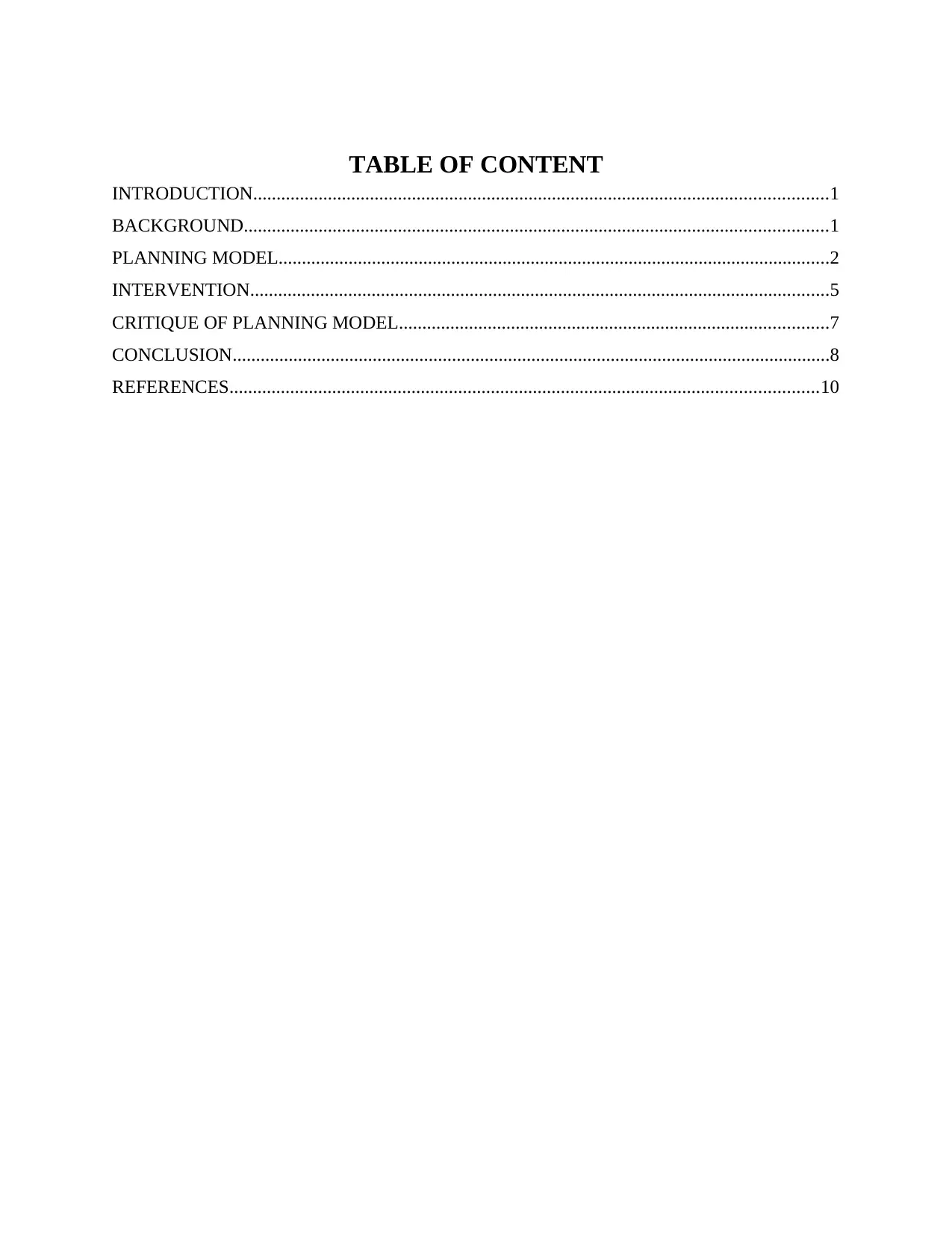
TABLE OF CONTENT
INTRODUCTION...........................................................................................................................1
BACKGROUND.............................................................................................................................1
PLANNING MODEL......................................................................................................................2
INTERVENTION............................................................................................................................5
CRITIQUE OF PLANNING MODEL............................................................................................7
CONCLUSION................................................................................................................................8
REFERENCES..............................................................................................................................10
INTRODUCTION...........................................................................................................................1
BACKGROUND.............................................................................................................................1
PLANNING MODEL......................................................................................................................2
INTERVENTION............................................................................................................................5
CRITIQUE OF PLANNING MODEL............................................................................................7
CONCLUSION................................................................................................................................8
REFERENCES..............................................................................................................................10
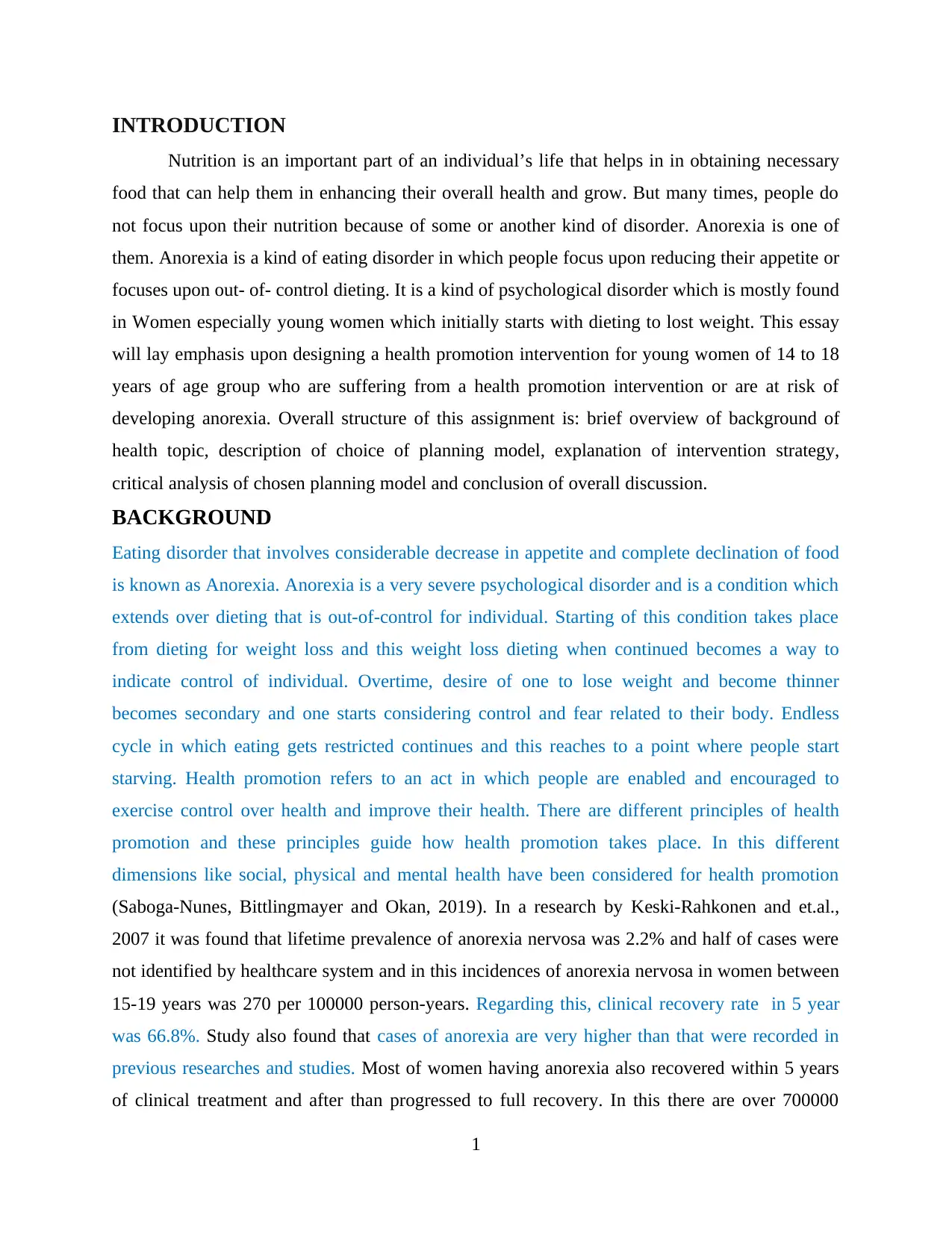
INTRODUCTION
Nutrition is an important part of an individual’s life that helps in in obtaining necessary
food that can help them in enhancing their overall health and grow. But many times, people do
not focus upon their nutrition because of some or another kind of disorder. Anorexia is one of
them. Anorexia is a kind of eating disorder in which people focus upon reducing their appetite or
focuses upon out- of- control dieting. It is a kind of psychological disorder which is mostly found
in Women especially young women which initially starts with dieting to lost weight. This essay
will lay emphasis upon designing a health promotion intervention for young women of 14 to 18
years of age group who are suffering from a health promotion intervention or are at risk of
developing anorexia. Overall structure of this assignment is: brief overview of background of
health topic, description of choice of planning model, explanation of intervention strategy,
critical analysis of chosen planning model and conclusion of overall discussion.
BACKGROUND
Eating disorder that involves considerable decrease in appetite and complete declination of food
is known as Anorexia. Anorexia is a very severe psychological disorder and is a condition which
extends over dieting that is out-of-control for individual. Starting of this condition takes place
from dieting for weight loss and this weight loss dieting when continued becomes a way to
indicate control of individual. Overtime, desire of one to lose weight and become thinner
becomes secondary and one starts considering control and fear related to their body. Endless
cycle in which eating gets restricted continues and this reaches to a point where people start
starving. Health promotion refers to an act in which people are enabled and encouraged to
exercise control over health and improve their health. There are different principles of health
promotion and these principles guide how health promotion takes place. In this different
dimensions like social, physical and mental health have been considered for health promotion
(Saboga-Nunes, Bittlingmayer and Okan, 2019). In a research by Keski-Rahkonen and et.al.,
2007 it was found that lifetime prevalence of anorexia nervosa was 2.2% and half of cases were
not identified by healthcare system and in this incidences of anorexia nervosa in women between
15-19 years was 270 per 100000 person-years. Regarding this, clinical recovery rate in 5 year
was 66.8%. Study also found that cases of anorexia are very higher than that were recorded in
previous researches and studies. Most of women having anorexia also recovered within 5 years
of clinical treatment and after than progressed to full recovery. In this there are over 700000
1
Nutrition is an important part of an individual’s life that helps in in obtaining necessary
food that can help them in enhancing their overall health and grow. But many times, people do
not focus upon their nutrition because of some or another kind of disorder. Anorexia is one of
them. Anorexia is a kind of eating disorder in which people focus upon reducing their appetite or
focuses upon out- of- control dieting. It is a kind of psychological disorder which is mostly found
in Women especially young women which initially starts with dieting to lost weight. This essay
will lay emphasis upon designing a health promotion intervention for young women of 14 to 18
years of age group who are suffering from a health promotion intervention or are at risk of
developing anorexia. Overall structure of this assignment is: brief overview of background of
health topic, description of choice of planning model, explanation of intervention strategy,
critical analysis of chosen planning model and conclusion of overall discussion.
BACKGROUND
Eating disorder that involves considerable decrease in appetite and complete declination of food
is known as Anorexia. Anorexia is a very severe psychological disorder and is a condition which
extends over dieting that is out-of-control for individual. Starting of this condition takes place
from dieting for weight loss and this weight loss dieting when continued becomes a way to
indicate control of individual. Overtime, desire of one to lose weight and become thinner
becomes secondary and one starts considering control and fear related to their body. Endless
cycle in which eating gets restricted continues and this reaches to a point where people start
starving. Health promotion refers to an act in which people are enabled and encouraged to
exercise control over health and improve their health. There are different principles of health
promotion and these principles guide how health promotion takes place. In this different
dimensions like social, physical and mental health have been considered for health promotion
(Saboga-Nunes, Bittlingmayer and Okan, 2019). In a research by Keski-Rahkonen and et.al.,
2007 it was found that lifetime prevalence of anorexia nervosa was 2.2% and half of cases were
not identified by healthcare system and in this incidences of anorexia nervosa in women between
15-19 years was 270 per 100000 person-years. Regarding this, clinical recovery rate in 5 year
was 66.8%. Study also found that cases of anorexia are very higher than that were recorded in
previous researches and studies. Most of women having anorexia also recovered within 5 years
of clinical treatment and after than progressed to full recovery. In this there are over 700000
1
⊘ This is a preview!⊘
Do you want full access?
Subscribe today to unlock all pages.

Trusted by 1+ million students worldwide
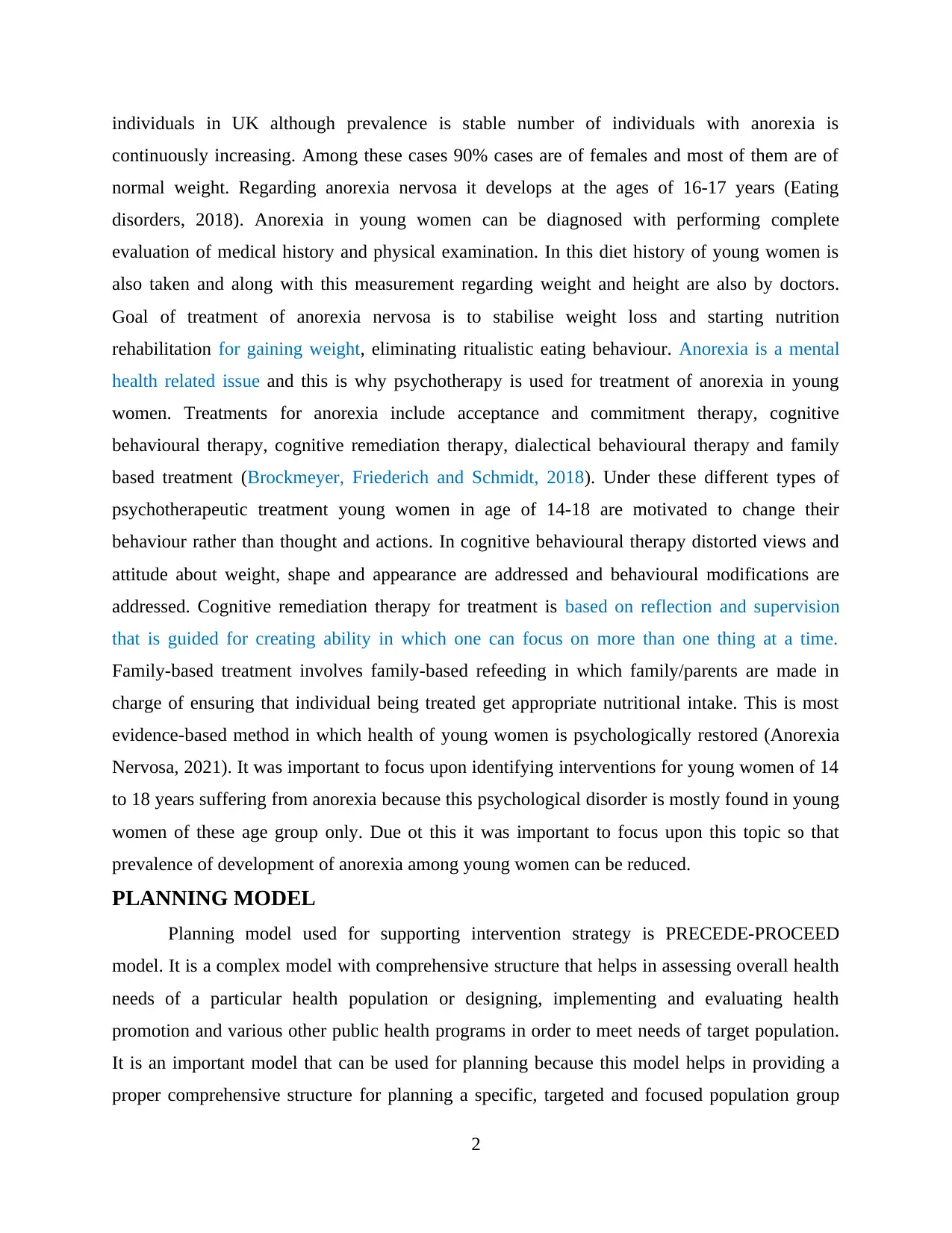
individuals in UK although prevalence is stable number of individuals with anorexia is
continuously increasing. Among these cases 90% cases are of females and most of them are of
normal weight. Regarding anorexia nervosa it develops at the ages of 16-17 years (Eating
disorders, 2018). Anorexia in young women can be diagnosed with performing complete
evaluation of medical history and physical examination. In this diet history of young women is
also taken and along with this measurement regarding weight and height are also by doctors.
Goal of treatment of anorexia nervosa is to stabilise weight loss and starting nutrition
rehabilitation for gaining weight, eliminating ritualistic eating behaviour. Anorexia is a mental
health related issue and this is why psychotherapy is used for treatment of anorexia in young
women. Treatments for anorexia include acceptance and commitment therapy, cognitive
behavioural therapy, cognitive remediation therapy, dialectical behavioural therapy and family
based treatment (Brockmeyer, Friederich and Schmidt, 2018). Under these different types of
psychotherapeutic treatment young women in age of 14-18 are motivated to change their
behaviour rather than thought and actions. In cognitive behavioural therapy distorted views and
attitude about weight, shape and appearance are addressed and behavioural modifications are
addressed. Cognitive remediation therapy for treatment is based on reflection and supervision
that is guided for creating ability in which one can focus on more than one thing at a time.
Family-based treatment involves family-based refeeding in which family/parents are made in
charge of ensuring that individual being treated get appropriate nutritional intake. This is most
evidence-based method in which health of young women is psychologically restored (Anorexia
Nervosa, 2021). It was important to focus upon identifying interventions for young women of 14
to 18 years suffering from anorexia because this psychological disorder is mostly found in young
women of these age group only. Due ot this it was important to focus upon this topic so that
prevalence of development of anorexia among young women can be reduced.
PLANNING MODEL
Planning model used for supporting intervention strategy is PRECEDE-PROCEED
model. It is a complex model with comprehensive structure that helps in assessing overall health
needs of a particular health population or designing, implementing and evaluating health
promotion and various other public health programs in order to meet needs of target population.
It is an important model that can be used for planning because this model helps in providing a
proper comprehensive structure for planning a specific, targeted and focused population group
2
continuously increasing. Among these cases 90% cases are of females and most of them are of
normal weight. Regarding anorexia nervosa it develops at the ages of 16-17 years (Eating
disorders, 2018). Anorexia in young women can be diagnosed with performing complete
evaluation of medical history and physical examination. In this diet history of young women is
also taken and along with this measurement regarding weight and height are also by doctors.
Goal of treatment of anorexia nervosa is to stabilise weight loss and starting nutrition
rehabilitation for gaining weight, eliminating ritualistic eating behaviour. Anorexia is a mental
health related issue and this is why psychotherapy is used for treatment of anorexia in young
women. Treatments for anorexia include acceptance and commitment therapy, cognitive
behavioural therapy, cognitive remediation therapy, dialectical behavioural therapy and family
based treatment (Brockmeyer, Friederich and Schmidt, 2018). Under these different types of
psychotherapeutic treatment young women in age of 14-18 are motivated to change their
behaviour rather than thought and actions. In cognitive behavioural therapy distorted views and
attitude about weight, shape and appearance are addressed and behavioural modifications are
addressed. Cognitive remediation therapy for treatment is based on reflection and supervision
that is guided for creating ability in which one can focus on more than one thing at a time.
Family-based treatment involves family-based refeeding in which family/parents are made in
charge of ensuring that individual being treated get appropriate nutritional intake. This is most
evidence-based method in which health of young women is psychologically restored (Anorexia
Nervosa, 2021). It was important to focus upon identifying interventions for young women of 14
to 18 years suffering from anorexia because this psychological disorder is mostly found in young
women of these age group only. Due ot this it was important to focus upon this topic so that
prevalence of development of anorexia among young women can be reduced.
PLANNING MODEL
Planning model used for supporting intervention strategy is PRECEDE-PROCEED
model. It is a complex model with comprehensive structure that helps in assessing overall health
needs of a particular health population or designing, implementing and evaluating health
promotion and various other public health programs in order to meet needs of target population.
It is an important model that can be used for planning because this model helps in providing a
proper comprehensive structure for planning a specific, targeted and focused population group
2
Paraphrase This Document
Need a fresh take? Get an instant paraphrase of this document with our AI Paraphraser
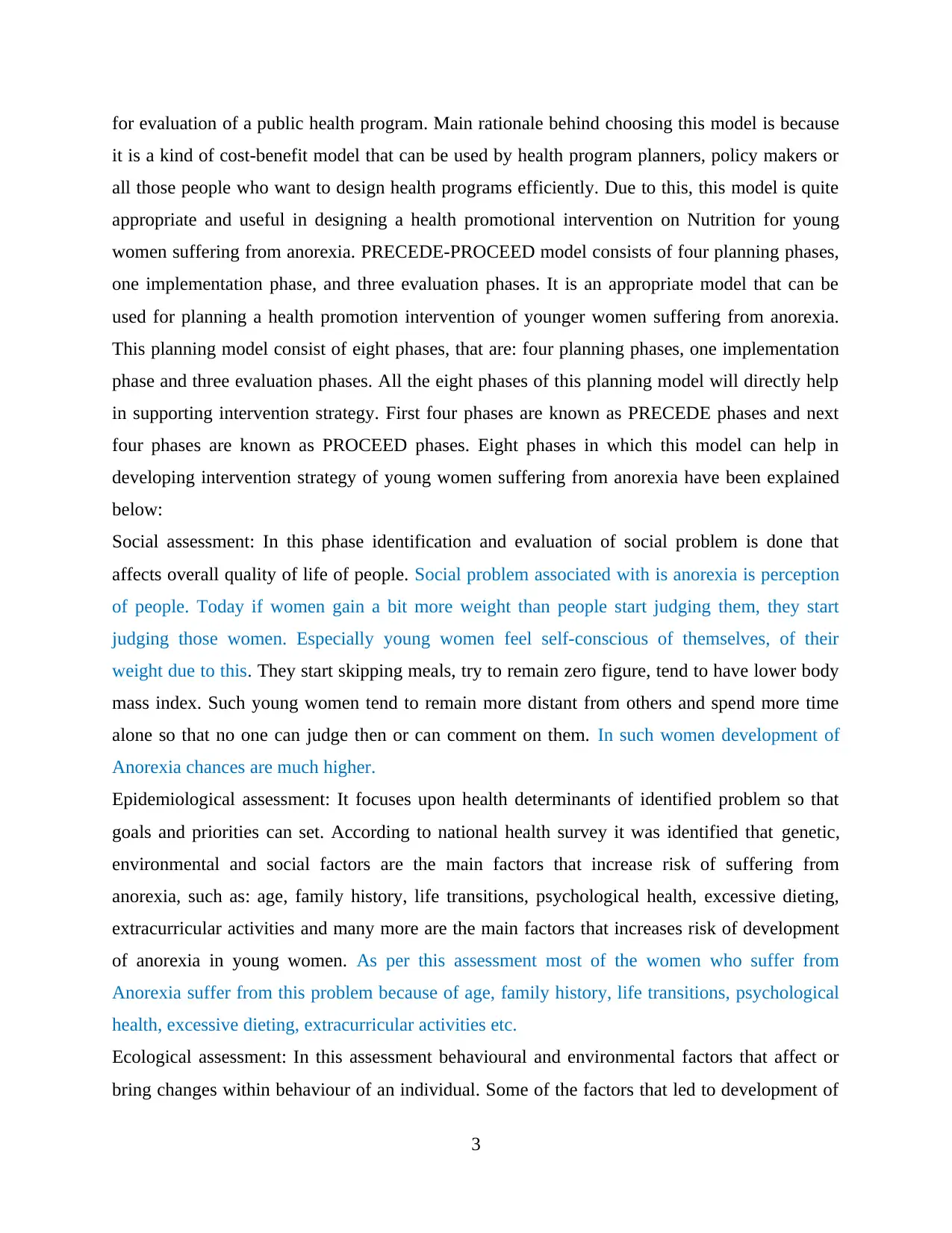
for evaluation of a public health program. Main rationale behind choosing this model is because
it is a kind of cost-benefit model that can be used by health program planners, policy makers or
all those people who want to design health programs efficiently. Due to this, this model is quite
appropriate and useful in designing a health promotional intervention on Nutrition for young
women suffering from anorexia. PRECEDE-PROCEED model consists of four planning phases,
one implementation phase, and three evaluation phases. It is an appropriate model that can be
used for planning a health promotion intervention of younger women suffering from anorexia.
This planning model consist of eight phases, that are: four planning phases, one implementation
phase and three evaluation phases. All the eight phases of this planning model will directly help
in supporting intervention strategy. First four phases are known as PRECEDE phases and next
four phases are known as PROCEED phases. Eight phases in which this model can help in
developing intervention strategy of young women suffering from anorexia have been explained
below:
Social assessment: In this phase identification and evaluation of social problem is done that
affects overall quality of life of people. Social problem associated with is anorexia is perception
of people. Today if women gain a bit more weight than people start judging them, they start
judging those women. Especially young women feel self-conscious of themselves, of their
weight due to this. They start skipping meals, try to remain zero figure, tend to have lower body
mass index. Such young women tend to remain more distant from others and spend more time
alone so that no one can judge then or can comment on them. In such women development of
Anorexia chances are much higher.
Epidemiological assessment: It focuses upon health determinants of identified problem so that
goals and priorities can set. According to national health survey it was identified that genetic,
environmental and social factors are the main factors that increase risk of suffering from
anorexia, such as: age, family history, life transitions, psychological health, excessive dieting,
extracurricular activities and many more are the main factors that increases risk of development
of anorexia in young women. As per this assessment most of the women who suffer from
Anorexia suffer from this problem because of age, family history, life transitions, psychological
health, excessive dieting, extracurricular activities etc.
Ecological assessment: In this assessment behavioural and environmental factors that affect or
bring changes within behaviour of an individual. Some of the factors that led to development of
3
it is a kind of cost-benefit model that can be used by health program planners, policy makers or
all those people who want to design health programs efficiently. Due to this, this model is quite
appropriate and useful in designing a health promotional intervention on Nutrition for young
women suffering from anorexia. PRECEDE-PROCEED model consists of four planning phases,
one implementation phase, and three evaluation phases. It is an appropriate model that can be
used for planning a health promotion intervention of younger women suffering from anorexia.
This planning model consist of eight phases, that are: four planning phases, one implementation
phase and three evaluation phases. All the eight phases of this planning model will directly help
in supporting intervention strategy. First four phases are known as PRECEDE phases and next
four phases are known as PROCEED phases. Eight phases in which this model can help in
developing intervention strategy of young women suffering from anorexia have been explained
below:
Social assessment: In this phase identification and evaluation of social problem is done that
affects overall quality of life of people. Social problem associated with is anorexia is perception
of people. Today if women gain a bit more weight than people start judging them, they start
judging those women. Especially young women feel self-conscious of themselves, of their
weight due to this. They start skipping meals, try to remain zero figure, tend to have lower body
mass index. Such young women tend to remain more distant from others and spend more time
alone so that no one can judge then or can comment on them. In such women development of
Anorexia chances are much higher.
Epidemiological assessment: It focuses upon health determinants of identified problem so that
goals and priorities can set. According to national health survey it was identified that genetic,
environmental and social factors are the main factors that increase risk of suffering from
anorexia, such as: age, family history, life transitions, psychological health, excessive dieting,
extracurricular activities and many more are the main factors that increases risk of development
of anorexia in young women. As per this assessment most of the women who suffer from
Anorexia suffer from this problem because of age, family history, life transitions, psychological
health, excessive dieting, extracurricular activities etc.
Ecological assessment: In this assessment behavioural and environmental factors that affect or
bring changes within behaviour of an individual. Some of the factors that led to development of
3
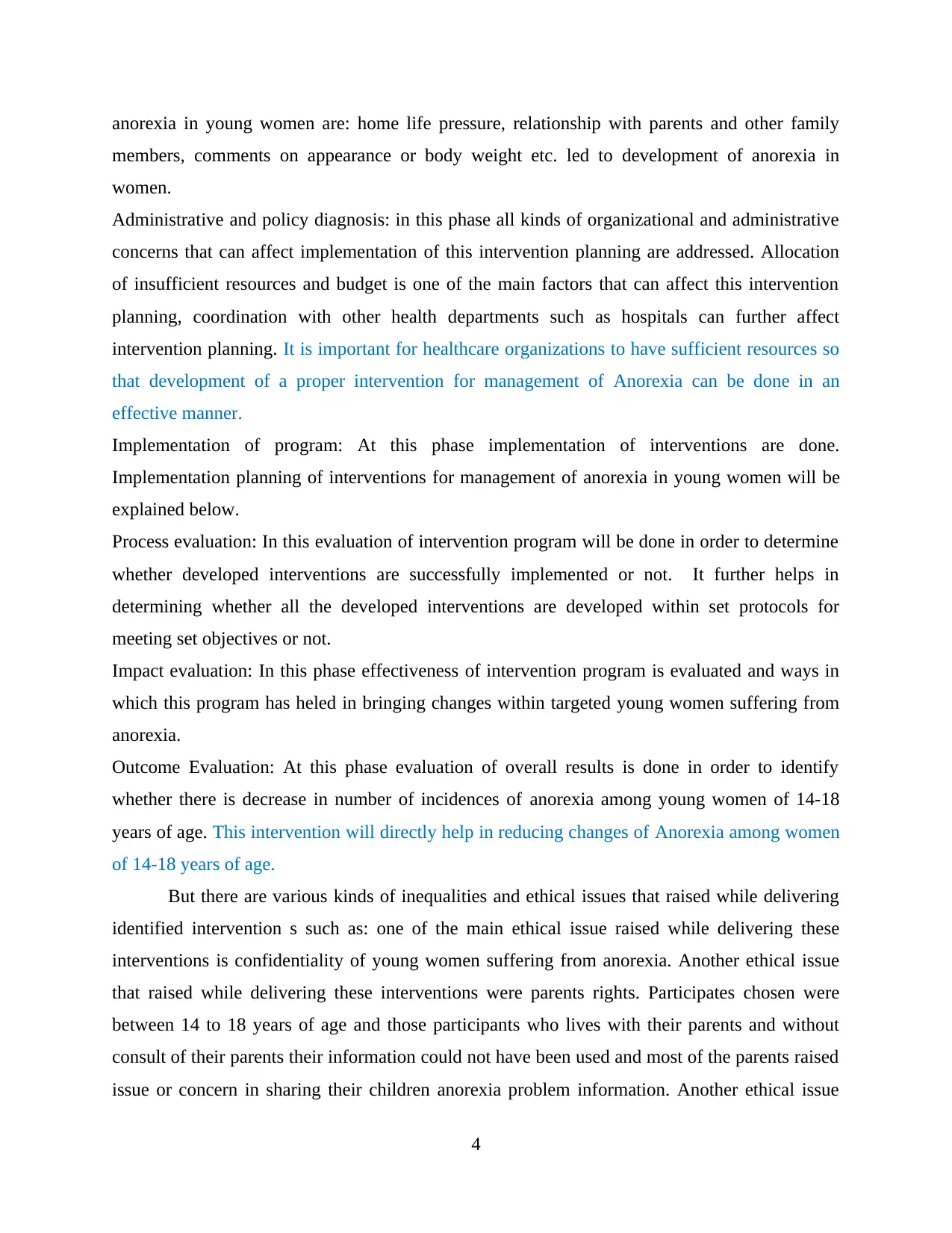
anorexia in young women are: home life pressure, relationship with parents and other family
members, comments on appearance or body weight etc. led to development of anorexia in
women.
Administrative and policy diagnosis: in this phase all kinds of organizational and administrative
concerns that can affect implementation of this intervention planning are addressed. Allocation
of insufficient resources and budget is one of the main factors that can affect this intervention
planning, coordination with other health departments such as hospitals can further affect
intervention planning. It is important for healthcare organizations to have sufficient resources so
that development of a proper intervention for management of Anorexia can be done in an
effective manner.
Implementation of program: At this phase implementation of interventions are done.
Implementation planning of interventions for management of anorexia in young women will be
explained below.
Process evaluation: In this evaluation of intervention program will be done in order to determine
whether developed interventions are successfully implemented or not. It further helps in
determining whether all the developed interventions are developed within set protocols for
meeting set objectives or not.
Impact evaluation: In this phase effectiveness of intervention program is evaluated and ways in
which this program has heled in bringing changes within targeted young women suffering from
anorexia.
Outcome Evaluation: At this phase evaluation of overall results is done in order to identify
whether there is decrease in number of incidences of anorexia among young women of 14-18
years of age. This intervention will directly help in reducing changes of Anorexia among women
of 14-18 years of age.
But there are various kinds of inequalities and ethical issues that raised while delivering
identified intervention s such as: one of the main ethical issue raised while delivering these
interventions is confidentiality of young women suffering from anorexia. Another ethical issue
that raised while delivering these interventions were parents rights. Participates chosen were
between 14 to 18 years of age and those participants who lives with their parents and without
consult of their parents their information could not have been used and most of the parents raised
issue or concern in sharing their children anorexia problem information. Another ethical issue
4
members, comments on appearance or body weight etc. led to development of anorexia in
women.
Administrative and policy diagnosis: in this phase all kinds of organizational and administrative
concerns that can affect implementation of this intervention planning are addressed. Allocation
of insufficient resources and budget is one of the main factors that can affect this intervention
planning, coordination with other health departments such as hospitals can further affect
intervention planning. It is important for healthcare organizations to have sufficient resources so
that development of a proper intervention for management of Anorexia can be done in an
effective manner.
Implementation of program: At this phase implementation of interventions are done.
Implementation planning of interventions for management of anorexia in young women will be
explained below.
Process evaluation: In this evaluation of intervention program will be done in order to determine
whether developed interventions are successfully implemented or not. It further helps in
determining whether all the developed interventions are developed within set protocols for
meeting set objectives or not.
Impact evaluation: In this phase effectiveness of intervention program is evaluated and ways in
which this program has heled in bringing changes within targeted young women suffering from
anorexia.
Outcome Evaluation: At this phase evaluation of overall results is done in order to identify
whether there is decrease in number of incidences of anorexia among young women of 14-18
years of age. This intervention will directly help in reducing changes of Anorexia among women
of 14-18 years of age.
But there are various kinds of inequalities and ethical issues that raised while delivering
identified intervention s such as: one of the main ethical issue raised while delivering these
interventions is confidentiality of young women suffering from anorexia. Another ethical issue
that raised while delivering these interventions were parents rights. Participates chosen were
between 14 to 18 years of age and those participants who lives with their parents and without
consult of their parents their information could not have been used and most of the parents raised
issue or concern in sharing their children anorexia problem information. Another ethical issue
4
⊘ This is a preview!⊘
Do you want full access?
Subscribe today to unlock all pages.

Trusted by 1+ million students worldwide
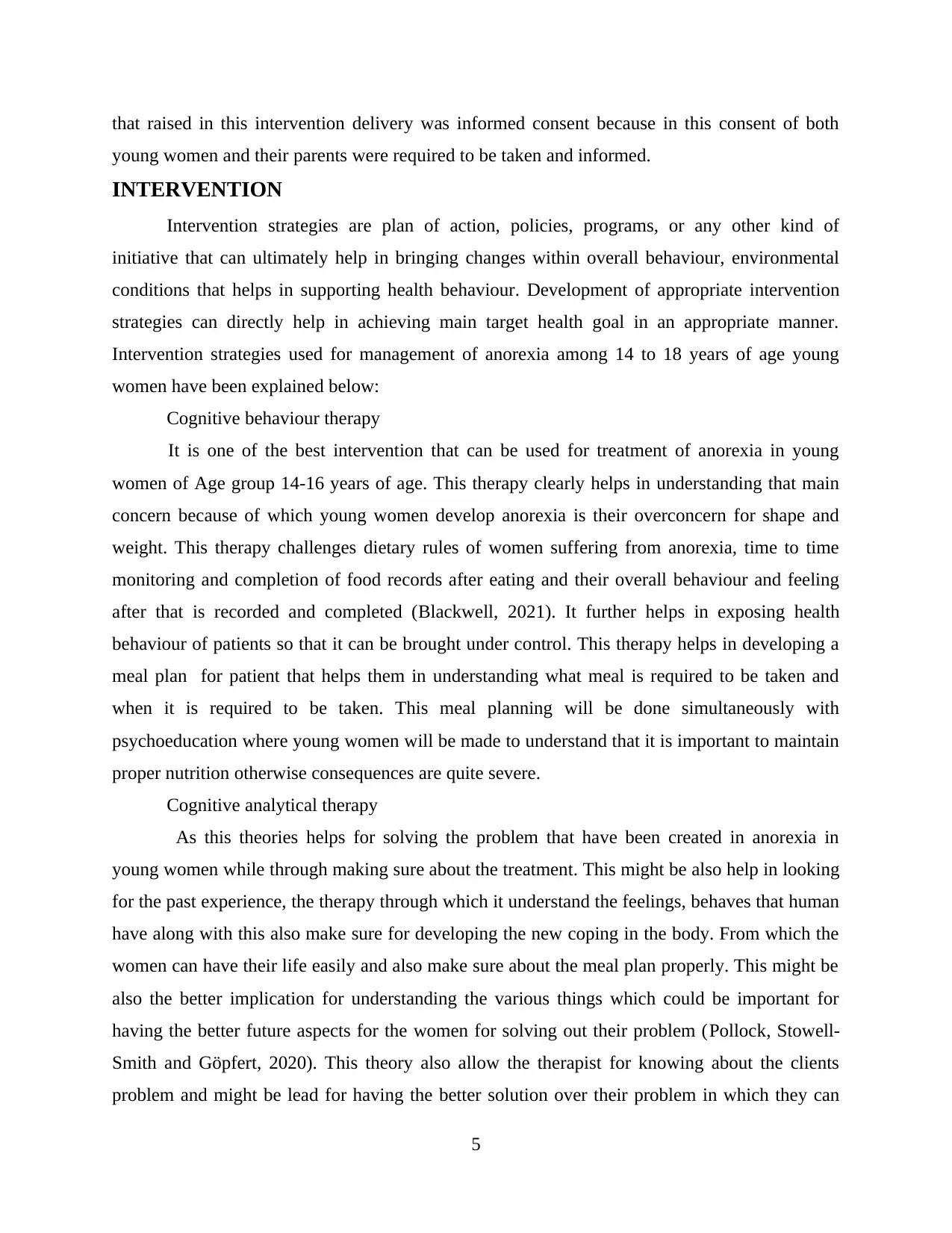
that raised in this intervention delivery was informed consent because in this consent of both
young women and their parents were required to be taken and informed.
INTERVENTION
Intervention strategies are plan of action, policies, programs, or any other kind of
initiative that can ultimately help in bringing changes within overall behaviour, environmental
conditions that helps in supporting health behaviour. Development of appropriate intervention
strategies can directly help in achieving main target health goal in an appropriate manner.
Intervention strategies used for management of anorexia among 14 to 18 years of age young
women have been explained below:
Cognitive behaviour therapy
It is one of the best intervention that can be used for treatment of anorexia in young
women of Age group 14-16 years of age. This therapy clearly helps in understanding that main
concern because of which young women develop anorexia is their overconcern for shape and
weight. This therapy challenges dietary rules of women suffering from anorexia, time to time
monitoring and completion of food records after eating and their overall behaviour and feeling
after that is recorded and completed (Blackwell, 2021). It further helps in exposing health
behaviour of patients so that it can be brought under control. This therapy helps in developing a
meal plan for patient that helps them in understanding what meal is required to be taken and
when it is required to be taken. This meal planning will be done simultaneously with
psychoeducation where young women will be made to understand that it is important to maintain
proper nutrition otherwise consequences are quite severe.
Cognitive analytical therapy
As this theories helps for solving the problem that have been created in anorexia in
young women while through making sure about the treatment. This might be also help in looking
for the past experience, the therapy through which it understand the feelings, behaves that human
have along with this also make sure for developing the new coping in the body. From which the
women can have their life easily and also make sure about the meal plan properly. This might be
also the better implication for understanding the various things which could be important for
having the better future aspects for the women for solving out their problem (Pollock, Stowell-
Smith and Göpfert, 2020). This theory also allow the therapist for knowing about the clients
problem and might be lead for having the better solution over their problem in which they can
5
young women and their parents were required to be taken and informed.
INTERVENTION
Intervention strategies are plan of action, policies, programs, or any other kind of
initiative that can ultimately help in bringing changes within overall behaviour, environmental
conditions that helps in supporting health behaviour. Development of appropriate intervention
strategies can directly help in achieving main target health goal in an appropriate manner.
Intervention strategies used for management of anorexia among 14 to 18 years of age young
women have been explained below:
Cognitive behaviour therapy
It is one of the best intervention that can be used for treatment of anorexia in young
women of Age group 14-16 years of age. This therapy clearly helps in understanding that main
concern because of which young women develop anorexia is their overconcern for shape and
weight. This therapy challenges dietary rules of women suffering from anorexia, time to time
monitoring and completion of food records after eating and their overall behaviour and feeling
after that is recorded and completed (Blackwell, 2021). It further helps in exposing health
behaviour of patients so that it can be brought under control. This therapy helps in developing a
meal plan for patient that helps them in understanding what meal is required to be taken and
when it is required to be taken. This meal planning will be done simultaneously with
psychoeducation where young women will be made to understand that it is important to maintain
proper nutrition otherwise consequences are quite severe.
Cognitive analytical therapy
As this theories helps for solving the problem that have been created in anorexia in
young women while through making sure about the treatment. This might be also help in looking
for the past experience, the therapy through which it understand the feelings, behaves that human
have along with this also make sure for developing the new coping in the body. From which the
women can have their life easily and also make sure about the meal plan properly. This might be
also the better implication for understanding the various things which could be important for
having the better future aspects for the women for solving out their problem (Pollock, Stowell-
Smith and Göpfert, 2020). This theory also allow the therapist for knowing about the clients
problem and might be lead for having the better solution over their problem in which they can
5
Paraphrase This Document
Need a fresh take? Get an instant paraphrase of this document with our AI Paraphraser
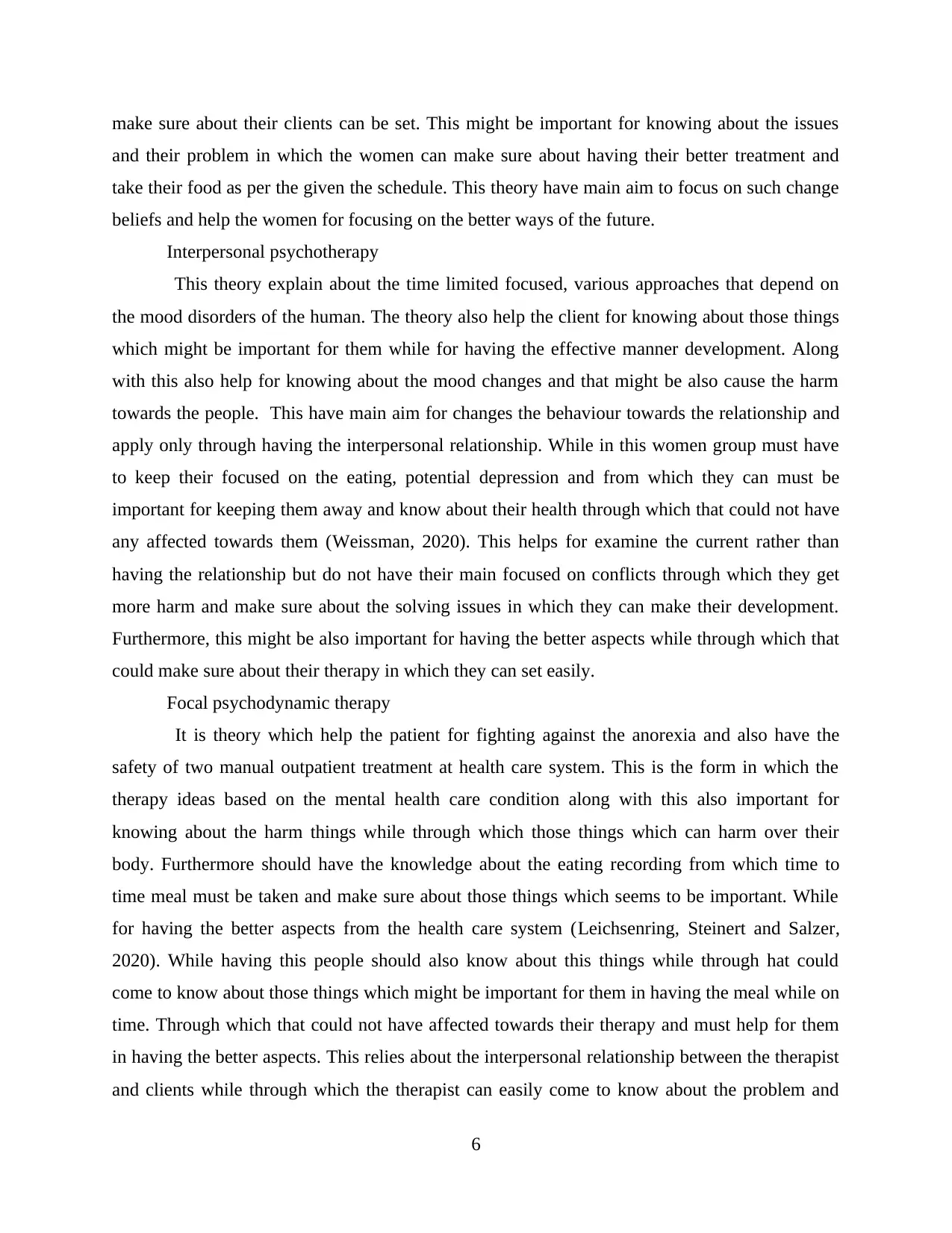
make sure about their clients can be set. This might be important for knowing about the issues
and their problem in which the women can make sure about having their better treatment and
take their food as per the given the schedule. This theory have main aim to focus on such change
beliefs and help the women for focusing on the better ways of the future.
Interpersonal psychotherapy
This theory explain about the time limited focused, various approaches that depend on
the mood disorders of the human. The theory also help the client for knowing about those things
which might be important for them while for having the effective manner development. Along
with this also help for knowing about the mood changes and that might be also cause the harm
towards the people. This have main aim for changes the behaviour towards the relationship and
apply only through having the interpersonal relationship. While in this women group must have
to keep their focused on the eating, potential depression and from which they can must be
important for keeping them away and know about their health through which that could not have
any affected towards them (Weissman, 2020). This helps for examine the current rather than
having the relationship but do not have their main focused on conflicts through which they get
more harm and make sure about the solving issues in which they can make their development.
Furthermore, this might be also important for having the better aspects while through which that
could make sure about their therapy in which they can set easily.
Focal psychodynamic therapy
It is theory which help the patient for fighting against the anorexia and also have the
safety of two manual outpatient treatment at health care system. This is the form in which the
therapy ideas based on the mental health care condition along with this also important for
knowing about the harm things while through which those things which can harm over their
body. Furthermore should have the knowledge about the eating recording from which time to
time meal must be taken and make sure about those things which seems to be important. While
for having the better aspects from the health care system (Leichsenring, Steinert and Salzer,
2020). While having this people should also know about this things while through hat could
come to know about those things which might be important for them in having the meal while on
time. Through which that could not have affected towards their therapy and must help for them
in having the better aspects. This relies about the interpersonal relationship between the therapist
and clients while through which the therapist can easily come to know about the problem and
6
and their problem in which the women can make sure about having their better treatment and
take their food as per the given the schedule. This theory have main aim to focus on such change
beliefs and help the women for focusing on the better ways of the future.
Interpersonal psychotherapy
This theory explain about the time limited focused, various approaches that depend on
the mood disorders of the human. The theory also help the client for knowing about those things
which might be important for them while for having the effective manner development. Along
with this also help for knowing about the mood changes and that might be also cause the harm
towards the people. This have main aim for changes the behaviour towards the relationship and
apply only through having the interpersonal relationship. While in this women group must have
to keep their focused on the eating, potential depression and from which they can must be
important for keeping them away and know about their health through which that could not have
any affected towards them (Weissman, 2020). This helps for examine the current rather than
having the relationship but do not have their main focused on conflicts through which they get
more harm and make sure about the solving issues in which they can make their development.
Furthermore, this might be also important for having the better aspects while through which that
could make sure about their therapy in which they can set easily.
Focal psychodynamic therapy
It is theory which help the patient for fighting against the anorexia and also have the
safety of two manual outpatient treatment at health care system. This is the form in which the
therapy ideas based on the mental health care condition along with this also important for
knowing about the harm things while through which those things which can harm over their
body. Furthermore should have the knowledge about the eating recording from which time to
time meal must be taken and make sure about those things which seems to be important. While
for having the better aspects from the health care system (Leichsenring, Steinert and Salzer,
2020). While having this people should also know about this things while through hat could
come to know about those things which might be important for them in having the meal while on
time. Through which that could not have affected towards their therapy and must help for them
in having the better aspects. This relies about the interpersonal relationship between the therapist
and clients while through which the therapist can easily come to know about the problem and
6
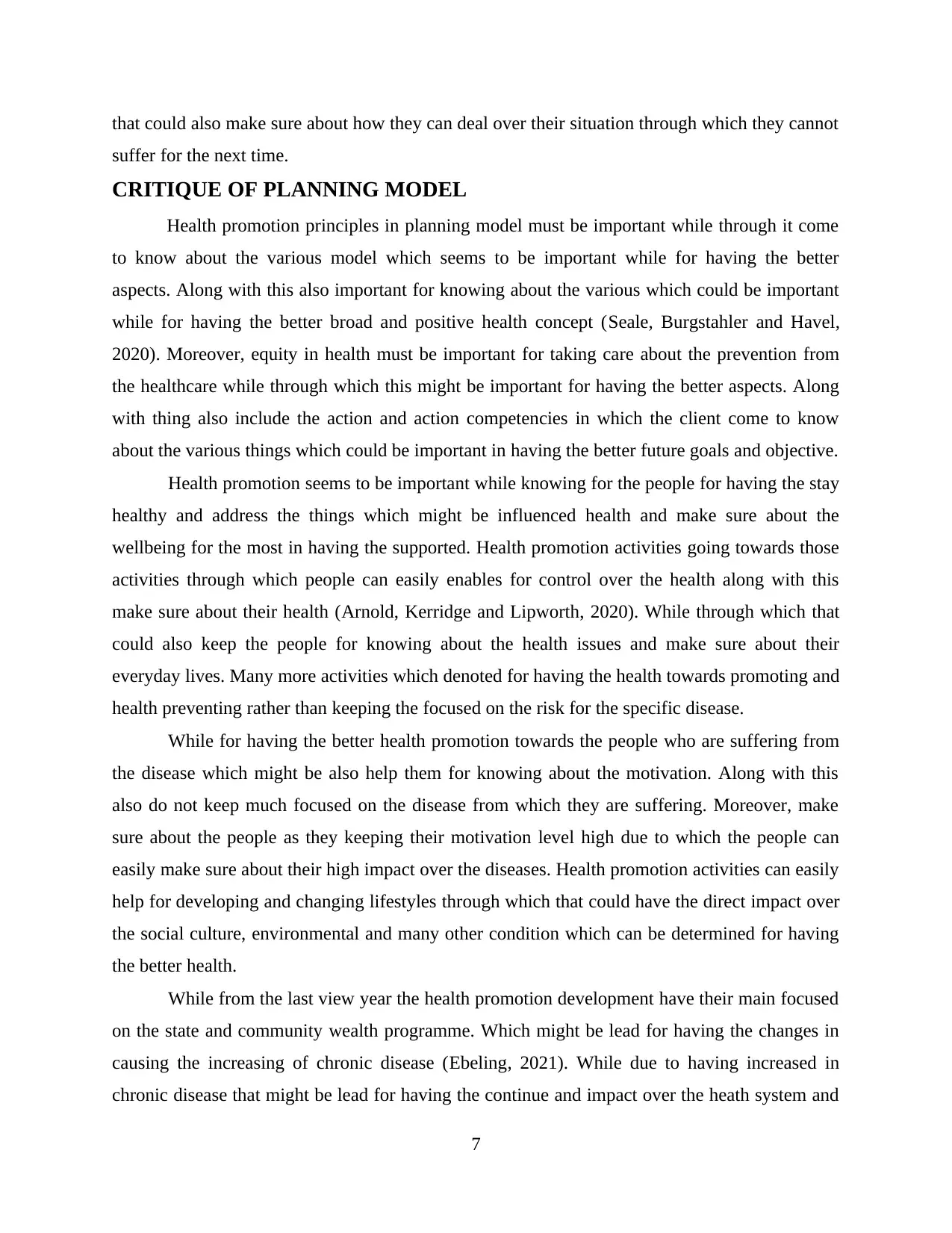
that could also make sure about how they can deal over their situation through which they cannot
suffer for the next time.
CRITIQUE OF PLANNING MODEL
Health promotion principles in planning model must be important while through it come
to know about the various model which seems to be important while for having the better
aspects. Along with this also important for knowing about the various which could be important
while for having the better broad and positive health concept (Seale, Burgstahler and Havel,
2020). Moreover, equity in health must be important for taking care about the prevention from
the healthcare while through which this might be important for having the better aspects. Along
with thing also include the action and action competencies in which the client come to know
about the various things which could be important in having the better future goals and objective.
Health promotion seems to be important while knowing for the people for having the stay
healthy and address the things which might be influenced health and make sure about the
wellbeing for the most in having the supported. Health promotion activities going towards those
activities through which people can easily enables for control over the health along with this
make sure about their health (Arnold, Kerridge and Lipworth, 2020). While through which that
could also keep the people for knowing about the health issues and make sure about their
everyday lives. Many more activities which denoted for having the health towards promoting and
health preventing rather than keeping the focused on the risk for the specific disease.
While for having the better health promotion towards the people who are suffering from
the disease which might be also help them for knowing about the motivation. Along with this
also do not keep much focused on the disease from which they are suffering. Moreover, make
sure about the people as they keeping their motivation level high due to which the people can
easily make sure about their high impact over the diseases. Health promotion activities can easily
help for developing and changing lifestyles through which that could have the direct impact over
the social culture, environmental and many other condition which can be determined for having
the better health.
While from the last view year the health promotion development have their main focused
on the state and community wealth programme. Which might be lead for having the changes in
causing the increasing of chronic disease (Ebeling, 2021). While due to having increased in
chronic disease that might be lead for having the continue and impact over the heath system and
7
suffer for the next time.
CRITIQUE OF PLANNING MODEL
Health promotion principles in planning model must be important while through it come
to know about the various model which seems to be important while for having the better
aspects. Along with this also important for knowing about the various which could be important
while for having the better broad and positive health concept (Seale, Burgstahler and Havel,
2020). Moreover, equity in health must be important for taking care about the prevention from
the healthcare while through which this might be important for having the better aspects. Along
with thing also include the action and action competencies in which the client come to know
about the various things which could be important in having the better future goals and objective.
Health promotion seems to be important while knowing for the people for having the stay
healthy and address the things which might be influenced health and make sure about the
wellbeing for the most in having the supported. Health promotion activities going towards those
activities through which people can easily enables for control over the health along with this
make sure about their health (Arnold, Kerridge and Lipworth, 2020). While through which that
could also keep the people for knowing about the health issues and make sure about their
everyday lives. Many more activities which denoted for having the health towards promoting and
health preventing rather than keeping the focused on the risk for the specific disease.
While for having the better health promotion towards the people who are suffering from
the disease which might be also help them for knowing about the motivation. Along with this
also do not keep much focused on the disease from which they are suffering. Moreover, make
sure about the people as they keeping their motivation level high due to which the people can
easily make sure about their high impact over the diseases. Health promotion activities can easily
help for developing and changing lifestyles through which that could have the direct impact over
the social culture, environmental and many other condition which can be determined for having
the better health.
While from the last view year the health promotion development have their main focused
on the state and community wealth programme. Which might be lead for having the changes in
causing the increasing of chronic disease (Ebeling, 2021). While due to having increased in
chronic disease that might be lead for having the continue and impact over the heath system and
7
⊘ This is a preview!⊘
Do you want full access?
Subscribe today to unlock all pages.

Trusted by 1+ million students worldwide
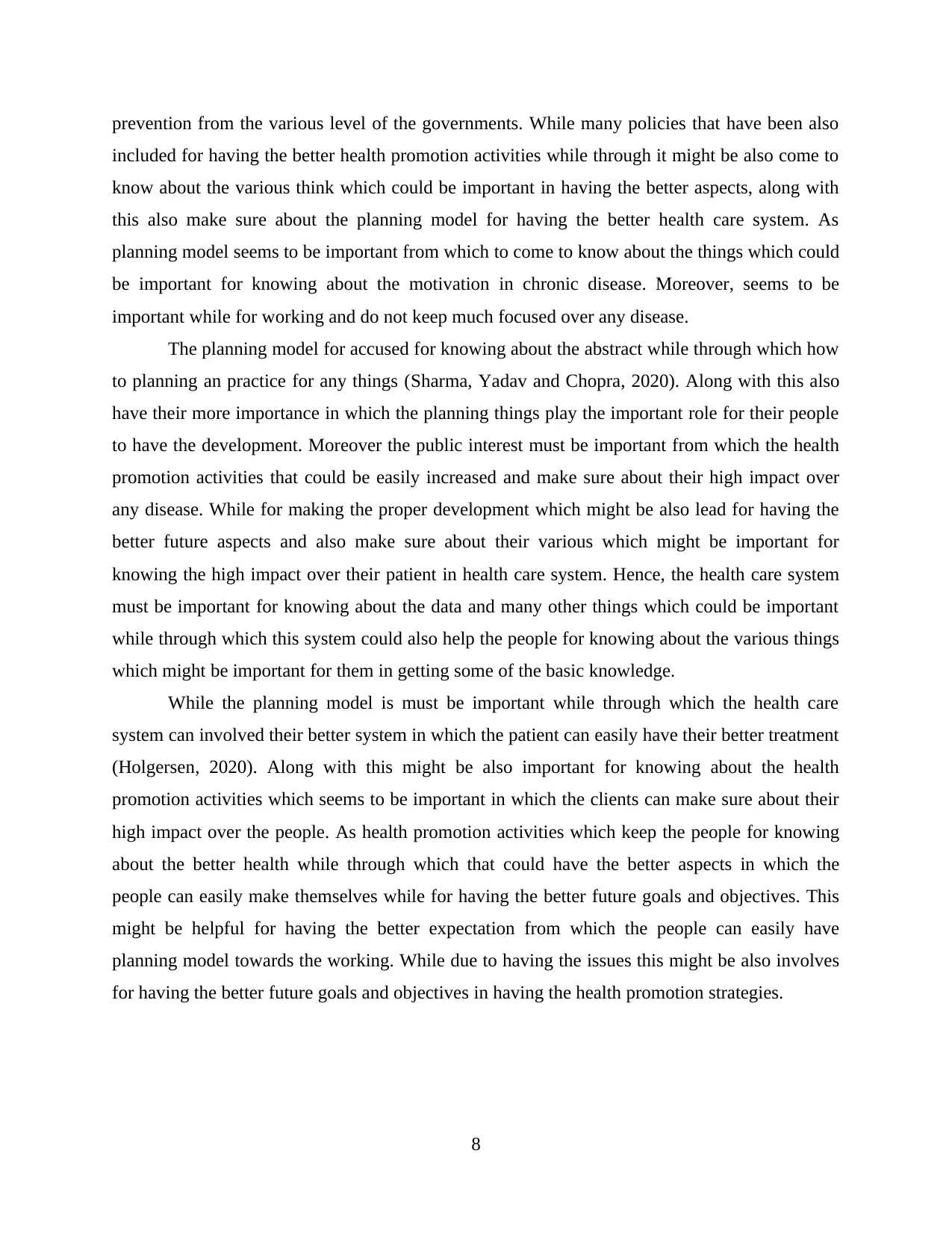
prevention from the various level of the governments. While many policies that have been also
included for having the better health promotion activities while through it might be also come to
know about the various think which could be important in having the better aspects, along with
this also make sure about the planning model for having the better health care system. As
planning model seems to be important from which to come to know about the things which could
be important for knowing about the motivation in chronic disease. Moreover, seems to be
important while for working and do not keep much focused over any disease.
The planning model for accused for knowing about the abstract while through which how
to planning an practice for any things (Sharma, Yadav and Chopra, 2020). Along with this also
have their more importance in which the planning things play the important role for their people
to have the development. Moreover the public interest must be important from which the health
promotion activities that could be easily increased and make sure about their high impact over
any disease. While for making the proper development which might be also lead for having the
better future aspects and also make sure about their various which might be important for
knowing the high impact over their patient in health care system. Hence, the health care system
must be important for knowing about the data and many other things which could be important
while through which this system could also help the people for knowing about the various things
which might be important for them in getting some of the basic knowledge.
While the planning model is must be important while through which the health care
system can involved their better system in which the patient can easily have their better treatment
(Holgersen, 2020). Along with this might be also important for knowing about the health
promotion activities which seems to be important in which the clients can make sure about their
high impact over the people. As health promotion activities which keep the people for knowing
about the better health while through which that could have the better aspects in which the
people can easily make themselves while for having the better future goals and objectives. This
might be helpful for having the better expectation from which the people can easily have
planning model towards the working. While due to having the issues this might be also involves
for having the better future goals and objectives in having the health promotion strategies.
8
included for having the better health promotion activities while through it might be also come to
know about the various think which could be important in having the better aspects, along with
this also make sure about the planning model for having the better health care system. As
planning model seems to be important from which to come to know about the things which could
be important for knowing about the motivation in chronic disease. Moreover, seems to be
important while for working and do not keep much focused over any disease.
The planning model for accused for knowing about the abstract while through which how
to planning an practice for any things (Sharma, Yadav and Chopra, 2020). Along with this also
have their more importance in which the planning things play the important role for their people
to have the development. Moreover the public interest must be important from which the health
promotion activities that could be easily increased and make sure about their high impact over
any disease. While for making the proper development which might be also lead for having the
better future aspects and also make sure about their various which might be important for
knowing the high impact over their patient in health care system. Hence, the health care system
must be important for knowing about the data and many other things which could be important
while through which this system could also help the people for knowing about the various things
which might be important for them in getting some of the basic knowledge.
While the planning model is must be important while through which the health care
system can involved their better system in which the patient can easily have their better treatment
(Holgersen, 2020). Along with this might be also important for knowing about the health
promotion activities which seems to be important in which the clients can make sure about their
high impact over the people. As health promotion activities which keep the people for knowing
about the better health while through which that could have the better aspects in which the
people can easily make themselves while for having the better future goals and objectives. This
might be helpful for having the better expectation from which the people can easily have
planning model towards the working. While due to having the issues this might be also involves
for having the better future goals and objectives in having the health promotion strategies.
8
Paraphrase This Document
Need a fresh take? Get an instant paraphrase of this document with our AI Paraphraser
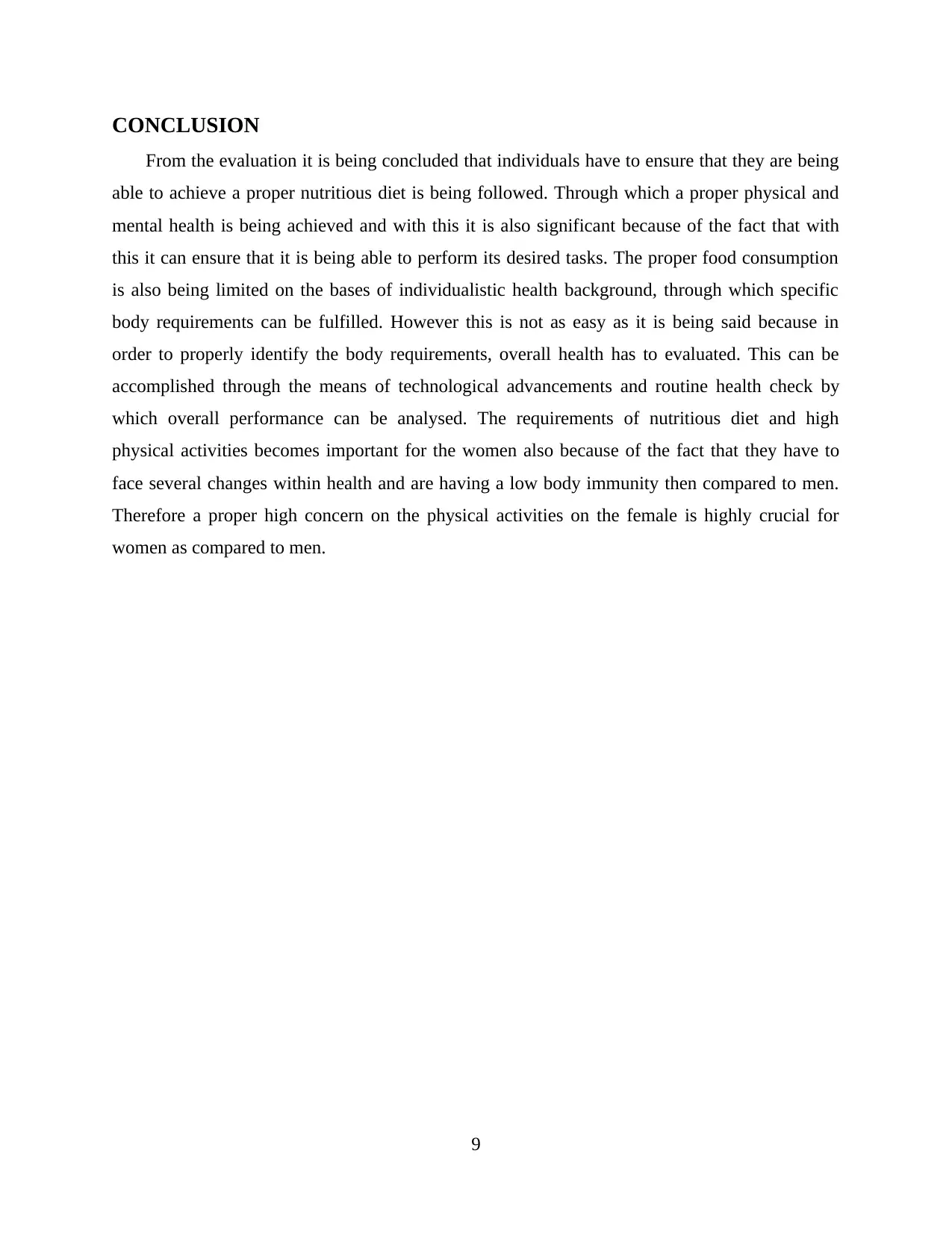
CONCLUSION
From the evaluation it is being concluded that individuals have to ensure that they are being
able to achieve a proper nutritious diet is being followed. Through which a proper physical and
mental health is being achieved and with this it is also significant because of the fact that with
this it can ensure that it is being able to perform its desired tasks. The proper food consumption
is also being limited on the bases of individualistic health background, through which specific
body requirements can be fulfilled. However this is not as easy as it is being said because in
order to properly identify the body requirements, overall health has to evaluated. This can be
accomplished through the means of technological advancements and routine health check by
which overall performance can be analysed. The requirements of nutritious diet and high
physical activities becomes important for the women also because of the fact that they have to
face several changes within health and are having a low body immunity then compared to men.
Therefore a proper high concern on the physical activities on the female is highly crucial for
women as compared to men.
9
From the evaluation it is being concluded that individuals have to ensure that they are being
able to achieve a proper nutritious diet is being followed. Through which a proper physical and
mental health is being achieved and with this it is also significant because of the fact that with
this it can ensure that it is being able to perform its desired tasks. The proper food consumption
is also being limited on the bases of individualistic health background, through which specific
body requirements can be fulfilled. However this is not as easy as it is being said because in
order to properly identify the body requirements, overall health has to evaluated. This can be
accomplished through the means of technological advancements and routine health check by
which overall performance can be analysed. The requirements of nutritious diet and high
physical activities becomes important for the women also because of the fact that they have to
face several changes within health and are having a low body immunity then compared to men.
Therefore a proper high concern on the physical activities on the female is highly crucial for
women as compared to men.
9
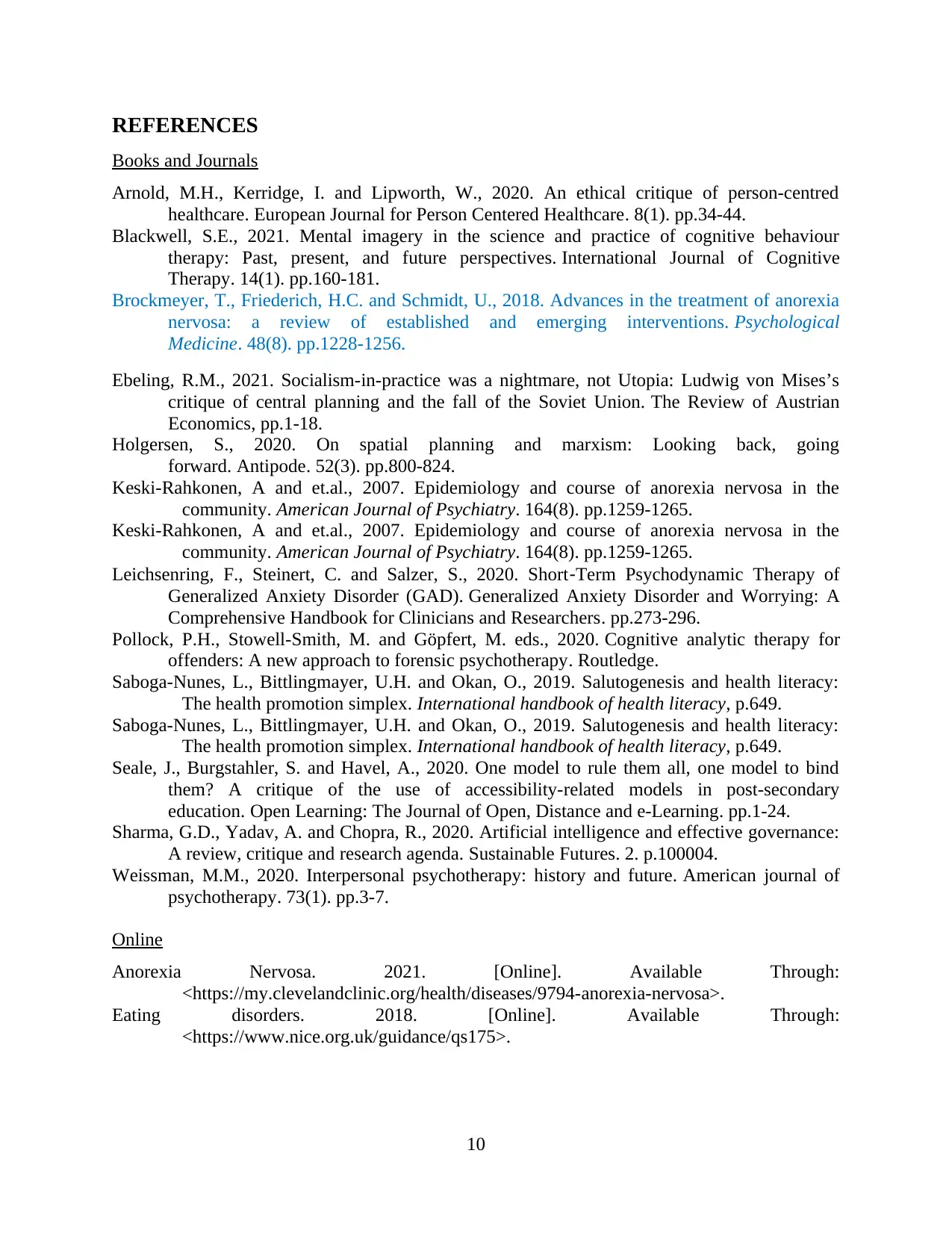
REFERENCES
Books and Journals
Arnold, M.H., Kerridge, I. and Lipworth, W., 2020. An ethical critique of person-centred
healthcare. European Journal for Person Centered Healthcare. 8(1). pp.34-44.
Blackwell, S.E., 2021. Mental imagery in the science and practice of cognitive behaviour
therapy: Past, present, and future perspectives. International Journal of Cognitive
Therapy. 14(1). pp.160-181.
Brockmeyer, T., Friederich, H.C. and Schmidt, U., 2018. Advances in the treatment of anorexia
nervosa: a review of established and emerging interventions. Psychological
Medicine. 48(8). pp.1228-1256.
Ebeling, R.M., 2021. Socialism-in-practice was a nightmare, not Utopia: Ludwig von Mises’s
critique of central planning and the fall of the Soviet Union. The Review of Austrian
Economics, pp.1-18.
Holgersen, S., 2020. On spatial planning and marxism: Looking back, going
forward. Antipode. 52(3). pp.800-824.
Keski-Rahkonen, A and et.al., 2007. Epidemiology and course of anorexia nervosa in the
community. American Journal of Psychiatry. 164(8). pp.1259-1265.
Keski-Rahkonen, A and et.al., 2007. Epidemiology and course of anorexia nervosa in the
community. American Journal of Psychiatry. 164(8). pp.1259-1265.
Leichsenring, F., Steinert, C. and Salzer, S., 2020. Short‐Term Psychodynamic Therapy of
Generalized Anxiety Disorder (GAD). Generalized Anxiety Disorder and Worrying: A
Comprehensive Handbook for Clinicians and Researchers. pp.273-296.
Pollock, P.H., Stowell-Smith, M. and Göpfert, M. eds., 2020. Cognitive analytic therapy for
offenders: A new approach to forensic psychotherapy. Routledge.
Saboga-Nunes, L., Bittlingmayer, U.H. and Okan, O., 2019. Salutogenesis and health literacy:
The health promotion simplex. International handbook of health literacy, p.649.
Saboga-Nunes, L., Bittlingmayer, U.H. and Okan, O., 2019. Salutogenesis and health literacy:
The health promotion simplex. International handbook of health literacy, p.649.
Seale, J., Burgstahler, S. and Havel, A., 2020. One model to rule them all, one model to bind
them? A critique of the use of accessibility-related models in post-secondary
education. Open Learning: The Journal of Open, Distance and e-Learning. pp.1-24.
Sharma, G.D., Yadav, A. and Chopra, R., 2020. Artificial intelligence and effective governance:
A review, critique and research agenda. Sustainable Futures. 2. p.100004.
Weissman, M.M., 2020. Interpersonal psychotherapy: history and future. American journal of
psychotherapy. 73(1). pp.3-7.
Online
Anorexia Nervosa. 2021. [Online]. Available Through:
<https://my.clevelandclinic.org/health/diseases/9794-anorexia-nervosa>.
Eating disorders. 2018. [Online]. Available Through:
<https://www.nice.org.uk/guidance/qs175>.
10
Books and Journals
Arnold, M.H., Kerridge, I. and Lipworth, W., 2020. An ethical critique of person-centred
healthcare. European Journal for Person Centered Healthcare. 8(1). pp.34-44.
Blackwell, S.E., 2021. Mental imagery in the science and practice of cognitive behaviour
therapy: Past, present, and future perspectives. International Journal of Cognitive
Therapy. 14(1). pp.160-181.
Brockmeyer, T., Friederich, H.C. and Schmidt, U., 2018. Advances in the treatment of anorexia
nervosa: a review of established and emerging interventions. Psychological
Medicine. 48(8). pp.1228-1256.
Ebeling, R.M., 2021. Socialism-in-practice was a nightmare, not Utopia: Ludwig von Mises’s
critique of central planning and the fall of the Soviet Union. The Review of Austrian
Economics, pp.1-18.
Holgersen, S., 2020. On spatial planning and marxism: Looking back, going
forward. Antipode. 52(3). pp.800-824.
Keski-Rahkonen, A and et.al., 2007. Epidemiology and course of anorexia nervosa in the
community. American Journal of Psychiatry. 164(8). pp.1259-1265.
Keski-Rahkonen, A and et.al., 2007. Epidemiology and course of anorexia nervosa in the
community. American Journal of Psychiatry. 164(8). pp.1259-1265.
Leichsenring, F., Steinert, C. and Salzer, S., 2020. Short‐Term Psychodynamic Therapy of
Generalized Anxiety Disorder (GAD). Generalized Anxiety Disorder and Worrying: A
Comprehensive Handbook for Clinicians and Researchers. pp.273-296.
Pollock, P.H., Stowell-Smith, M. and Göpfert, M. eds., 2020. Cognitive analytic therapy for
offenders: A new approach to forensic psychotherapy. Routledge.
Saboga-Nunes, L., Bittlingmayer, U.H. and Okan, O., 2019. Salutogenesis and health literacy:
The health promotion simplex. International handbook of health literacy, p.649.
Saboga-Nunes, L., Bittlingmayer, U.H. and Okan, O., 2019. Salutogenesis and health literacy:
The health promotion simplex. International handbook of health literacy, p.649.
Seale, J., Burgstahler, S. and Havel, A., 2020. One model to rule them all, one model to bind
them? A critique of the use of accessibility-related models in post-secondary
education. Open Learning: The Journal of Open, Distance and e-Learning. pp.1-24.
Sharma, G.D., Yadav, A. and Chopra, R., 2020. Artificial intelligence and effective governance:
A review, critique and research agenda. Sustainable Futures. 2. p.100004.
Weissman, M.M., 2020. Interpersonal psychotherapy: history and future. American journal of
psychotherapy. 73(1). pp.3-7.
Online
Anorexia Nervosa. 2021. [Online]. Available Through:
<https://my.clevelandclinic.org/health/diseases/9794-anorexia-nervosa>.
Eating disorders. 2018. [Online]. Available Through:
<https://www.nice.org.uk/guidance/qs175>.
10
⊘ This is a preview!⊘
Do you want full access?
Subscribe today to unlock all pages.

Trusted by 1+ million students worldwide
1 out of 12
Related Documents
Your All-in-One AI-Powered Toolkit for Academic Success.
+13062052269
info@desklib.com
Available 24*7 on WhatsApp / Email
![[object Object]](/_next/static/media/star-bottom.7253800d.svg)
Unlock your academic potential
Copyright © 2020–2025 A2Z Services. All Rights Reserved. Developed and managed by ZUCOL.





